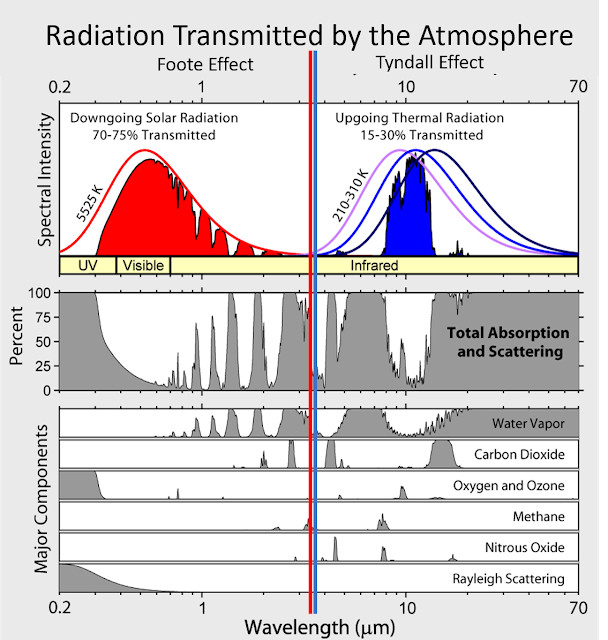
Yet another new puzzler
April 25, 2020Eli has always been fond of puzzlers, and it is well past time for a new one, the answer to which not only is useful for Twitterati, but also for climate modeling. Everybunny has seen the atmospheric absorption spectrum that Robert Rhode put together years ago elaborating on earlier versions in Goody and Yung
This figure shows the absorption bands in the Earth's atmosphere (middle panel) and the effect that this has on both solar radiation and upgoing thermal radiation (top panel). Individual absorption spectrum for major greenhouse gases plus Rayleigh scattering are shown in the lower panel. (R. Rhode w. a bit of remixing)Ask anybunny, or at least the ones into denial of climate change and they will point to Robert's figure and tell you that the CO2 absorption at 14.7 μ is overlapped by water vapor absorption so limiting CO2 will only have a small effect on the greenhouse effect, after all, water vapor accounts for 95% of the greenhouse effect. Ask Gavin and you get something not so different
Thus the effect of water vapour and clouds is between 66 and 85% – the range being due to the spectral overlaps with the other absorbers. These calculations were done with the GISS GCM radiation code, which matches line-by-line codes to about 10% – but the numbers are very similar to Ramanathan and Coakley (1978), and so probably aren’t too far off what you would get with any decent radiation code. I’ll get to ‘c)’ below….Eli, being a RTFM type as well as a jackleg molecular spectroscopist, or in this case a CTFT type has known for a long time that the overlaps between CO2 and water vapor are not important (clouds being a whole different thing)
So what is going on here. Even though there is very little overlap, why does everybunny think there is a lot, and how does the answer affect how one thinks about the greenhouse effect and the relative importance of various atmospheric components.
The answer which will take several posts to reach is, well Eli is thinking hard about coming out of retirement and writing a paper about it. It provides a different and better way of calculating the greenhouse warming potential of gases.



